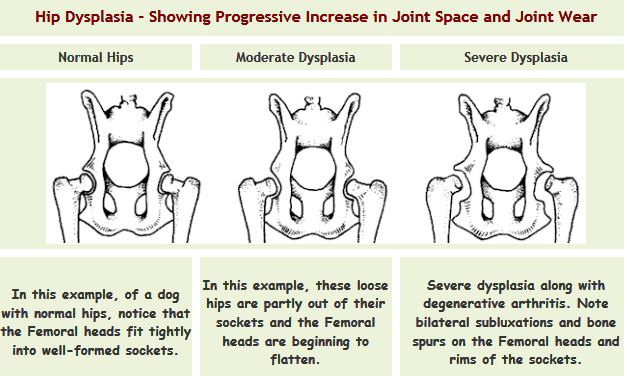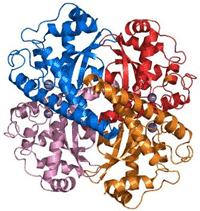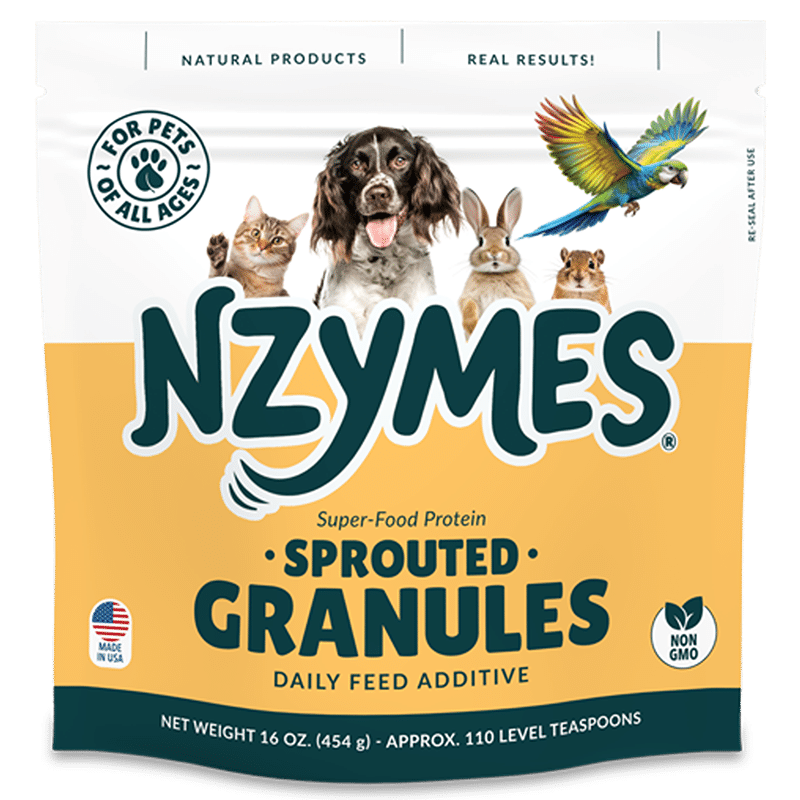Hip Dysplasia in Dogs – What it Is & What it Looks Like
Dog Hip Dysplasia is a condition which causes a malformed joint connection between the head of the femur (leg bone) and the pelvis of a dog. This results in irregular hip movement, which can be painful and immobilizing. Dysplastic dogs often have trouble with stairs, getting up from lying down, and mobility in general. After a time, arthritis can set in, making matters worse. Hip Dysplasia in dogs is one of the leading causes of canine immobility throughout the US and Canada.

How does Hip Dysplasia develop?
Experience shows us that most frequently, genetics is a huge determining factor for the development of Hip Dysplasia in dogs. Genes may be passed down from one or both parents. Reputable breeders will be sure to certify their breeding stock with the Orthopedic Foundation of America (OFA). This offers at least one level of assurance for prospective pet parents. Even then, recessive genes have been known to surface out of the blue resulting in dysplastic offspring.
Then there are breeders who are not-so-reputable, AKA – backyard breeders. Their primary motivation in breeding is money – pure and simple. It is not uncommon to hear of bitches that are bred too young, and too often, leaving them depleted. If the mother is stressed and emaciated, what does she have to pass on to her young? Name any popular breed and you can be guaranteed to find someone willing to make puppies for sale. Labs, Goldens, Shepherds, Rotties, Dobes, Newfies – are some of the more popular, large breed dogs, many of which are plagued with H.D. Many popular small breed dogs endure the same over-breeding scenario, and also develop hip dysplasia, but because of their smaller size, the symptoms are not as noticeable.
Yes. Outside of genetics, diet plays the next most critical role in ANY growing puppy. The old saying is true, “You can’t get a silk purse out of a sow’s ear”. Even so, there are no shortcuts to a sound nutritional regimen.
Unfortunately, many popular supermarket level foods are made with sub-par ingredients. These foods tend to be grain-based, utilize meat by-products and incorporate artificially created vitamins and poor quality minerals. Think of it this way, what if your dog were a house? These are the building materials that you are building your dog from. The old saying, “You are what you eat” is true. Without quality nutrients, the body will suffer, because it cannot utilize what is being brought in.
In a bone-growth survey involving over 5000 dogs, our dear friend Linda Arndt demonstrated, with x-ray verification, that bone growth disorders could both be created and corrected by nutritional means.
Even if your dog is already dysplastic, getting him on a quality diet can have a powerful impact on him.

If My dog has Hip Dysplasia, What Can I DO about it?
Historically, Hip Dysplasia in dogs has been addressed by 3 primary approaches. Sometimes 1, 2 or all 3 of these methods are used in concert to provide help for the pet in need.
- Surgery
- Pain-Killers
- Natural Supplements
Let’s briefly consider these options.
Surgery for Hip Dysplasia
There are a variety of surgical options to correct a malformed hip joint. The proper procedure depends on the severity of the individual situation. While these options have their differences, ANY surgical decision will have 3 things in common.
- Surgery is costly. Hip surgery is a serious, medical procedure. It will require putting your dog under anesthesia. Prices can range upwards to $5000 per each hip.
- There will be a lengthy period of convalescence afterward.
- There are NO Guarantees for success. Although many cases turn out wonderfully, in the end, no surgeon can guarantee the certainty of the outcome.
Pain-Killers for Hip Dysplasia – the Pros and Cons
Because of the enormous expense of surgery, it simply puts that option out of range for many people. Vets will often prescribe pain-killers to give the dogs more comfort, allowing them to move more freely. But this approach is not without its own risks. Popular medications, like Rimadyl, Duramax or others are known for their potential to cause liver damage or kidney troubles. Any dog on these meds should be routinely screened for elevated liver enzyme levels and Creatinine/BUN levels as well. It is also important to note that this approach does not fix the problem, it simply masks the pain.
Natural Supplements for Hip Dysplasia
There are a wide variety of natural products on the market. Some are quite effective, others not so much. With natural products, as with medications, the effect on an individual animal may vary from another animal with the same ailment or issue. Unlike medications, different natural products can often be used together without concern of interaction or overdose.
On the upside, there are generally very few negative “side effects” with natural products. Perhaps a digestive upset or loose stool may accompany their usage. This can be due to a detoxifying effect, and will often pass with time. On the downside, the natural approach may not produce the results you desire, but at least no harm has been done to other body systems in the process.
What makes Nzymes Supplements Unique?
There are a number of “Joint-Health” supplements on the market. A great number of them are Glucosamine based. Others contain a variety of herbs. Nutritional sulfur denoted as “MSM”, can bring an anti-inflammatory aspect to products that contain it. That is all just fine. There are many products that utilize some or all of these agents. Any product that can bring natural help and support to an animal in distress is a good thing. Nzymes, however, is in a class by itself.
“Live-Food” Enzymes – as a Resource – Makes the Difference
Nzymes Antioxidant Treats or Sprouted Granules harness “Live food” enzymes to bring about positive changes. Some may consider this statement as a marketing ploy, but the results speak for themselves. The sprouted material from which these products are derived is easily absorbed by the body. It is food, so the body knows what to do with it. From this food resource, the body is able to produce vast quantities of Antioxidant Enzymes.
Author’s Note: I was first introduced to the concept of using nutritional supplements when my own dog, Tigger, was bothered by a luxating patella (floating kneecap). I later discovered that this is very common among the smaller breeds. Anyway, he would hobble and limp everywhere at only 1 year of age. Long story short, after only a couple of weeks on the Nzymes Antioxidant Treats, he ran normally! Being a nuts-and-bolts kind of guy, I had to figure out WHY he got better. The more I researched into antioxidant enzymes, and their positive effect on body systems, the more it was cementing what I was seeing right before my eyes

The Connection between Antioxidant Enzymes and Joint Function:

Simply put, antioxidant enzymes are a part of the body’s own natural defense mechanism. Their job is to rid the cells of toxic free-radicals. This has a positive effect on the lubricating Synovial Fluid in the joints, and on inflammatory responses in the surrounding tissues.
The production of antioxidant enzymes hinges in large part on diet. Without a rich source of “live food” in the diet, antioxidant enzymes production drops off, and health takes a downward spiral. This is why the introduction of a simple supplement, like the Antioxidant Treats or Granules, can have such a profound impact on pets suffering from any variety of joint related problems, like Canine Hip Dysplasia.
Conclusion
When it comes to Hip Dysplasia, no nutritional supplement is going to magically correct the mal-formed joint – obviously. But antioxidant enzymes have the capacity to allow greatly improved mobility without harmful drugs or risky surgery. If a quality of life is what you are looking for, then antioxidant enzymes might be your ticket.
Authored by Mike Stansbury,
Operations Manager Nzymes.com





